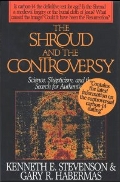The Shroud and the Controversy. By Kenneth E. Stevenson and Gary R. Habermas. Nashville: Thomas Nelson, Inc., 1990. 257 pp. Cloth, $15.95.
For those unfamiliar with the subject, the Shroud of Turin is a burial cloth dating back many centuries which contains a three-dimensional image-that is, with depth of field-of a man who was killed by crucifixion. For centuries it has been guarded at the Cathedral of Turin (Italy), hence its name. Many have concluded that the Shroud is actually the burial shroud of Jesus Christ of Nazareth, crucified in A.D. 29.
The scientific evidence indicates, as the book outlines in detail, that the image, although similar in appearance to a photographic negative, was not the work of a chemically or artistically-produced forgery. All known methods of forgery were attempted by a team of scientists known as STURP (Shroud of Turin Research Project) in order to reproduce the image. These attempts all ended in failure.
In their earlier book, Verdict on the Shroud, written in 1981, the authors were perhaps overly zealous in the use of statistical probability—an admission that they make in this latest work (pp. 15, 16). However lacking their initial approach may have been, in their most recent work Habermas and Stevenson have given to the public a masterpiece filled with objective data, scientific analyses, logical reasoning, relevant historical information, and a series of helpful photographs.
Although the subject of the Shroud has evoked much emotional response from both sides throughout the centuries, authors Stevenson and Habermas provide a detailed, scientific approach to the study in The Shroud and the Controversy. At the outset, they reassure the reader of their honest and objective approach by pointing out that since the time of the first book’s publication, Habermas has become slightly less optimistic, whereas Stevenson has remained equally convinced of the Shroud’s authenticity (p. 14). In their latest work, the authors give the pertinent data, and they ask the reader to draw his or her own conclusions.
The strongest angle of attack against the Shroud’s authenticity stems from the Carbon 14 dating of the cloth, which has dated the cloth between A.D. 1260 and 1390 (p. 55). The authors point out, however, that the STURP team did not follow the prescribed C-14 method which must test samples from totally different parts of an artifact. The dating samples of the Shroud were all taken from the same area near some patches known to have been sewn into the shroud in the 16th century after a fire burned some holes in it in 1532. Added to this is the fact that the Shroud was heavily handled during the Middle Ages. This produced contaminants which are known to affect C-14 dating; thus it is hard to be convinced of the dating results by STURP (p. 56).
Furthermore, a dating conducted in a nuclear accelerator at the University of California in 1982 showed two ends of the same thread to date separately at A.D. 200 and A.D. 1000 (p. 58)! Carbon 14 claims to have an accuracy range of ± 200 years. The A.D. 200 reading, taken together with the plus or minus factor of ±200 years, places the Shroud in the first century.
From a biblical and historical perspective, the authors’ detailed analysis of the wounds inflicted on the man who produced the image on the Shroud is much appreciated by this reviewer. The wounds suffered by Christ as recorded in the Gospels-from the scourging, the crown of thorns, and the beating of His face, to the crucifixion itself (nail wounds and spear wound)-all are evidenced in the image of the Shroud. Detailed photographs and computer enhanced imaging (including some in color) clearly show these injuries. The man whose body produced the image on the Shroud experienced the exact same wounds to the last detail as those suffered by our Lord.
Another interesting area of the authors’ study deals with evidence for the Resurrection contained in the Shroud. Since no known methods of human, mechanical, or chemical forgery were able to reproduce the image of the Shroud under the direction of STURP scientists, they concluded that it was produced by some “Unknown Energy Source” or by “Direct Contact + Unknown Variable” (p. 214)! Since the image was not produced by any natural means-as the scientists have indicated-we are left with a supernatural means.
In the reviewer’s opinion, Stevenson and Habermas give convincing evidence to show that the Shroud of Turin is indeed the burial cloth of Jesus Christ. Those who become convinced of the Shroud’s authenticity are cautioned by the authors to worship the Man who made the image, and not the image itself (pp. 20, 21). Even for skeptics, the book is well worth reading. I believe that anyone interested in the identity of Jesus Christ, whether a Christian or not, should read this book. According to the authors, many people expressed that they had trusted in Jesus Christ as a result of reading their first book, Verdict on the Shroud (p. 207). Possibly the reading of this book may similarly affect the spiritual lives of many readers.
Mark J. Farstad
Production Staff
Journal of the Grace Evangelical Society
Dallas, TX

